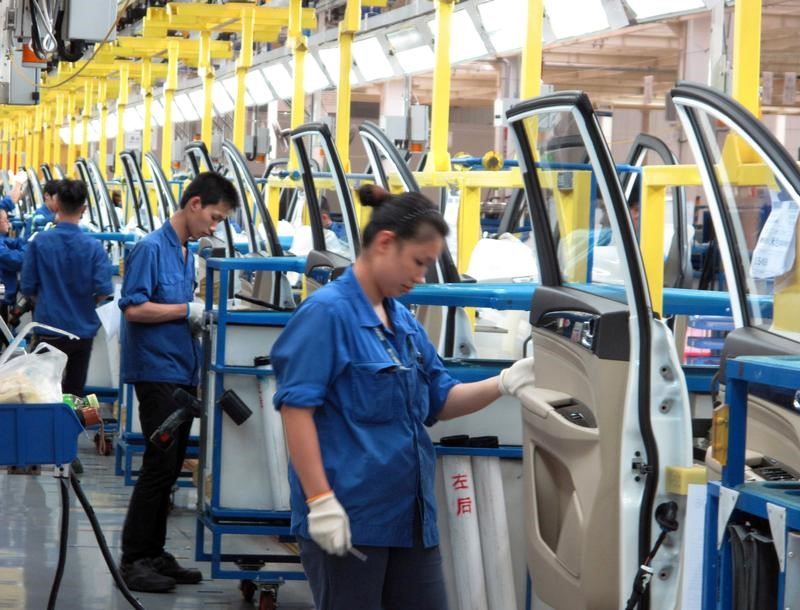By Elias Glenn and Lusha Zhang
BEIJING (Reuters) - Profits for China's industrial firms rose the most in three years in 2016 as a construction boom fueled a rally in prices of building materials from steel to cement, giving companies more flexibility to start chipping away at a mountain of debt.
Strong profit growth of 8.5 percent last year suggests there may be a solid pick-up in industrial investment in 2017, though many analysts still expect China's overall economic growth to cool to around 6.5 percent this year from 6.7 percent in 2016.
Industrial profits fell 2.3 percent in 2015.
Profits in December rose 2.3 percent from a year earlier to 844.4 billion yuan (97.2 billion pounds), the National Bureau of Statistics (NBS) said on Thursday, slowing sharply from growth of 14.5 percent in November.
But the earnings recovery remained uneven across the industrial sector, with coal miners and processors such as steel mills and oil refiners continuing to see sharper gains than other firms.
Profits in the coal mining sector surged 223.6 percent in 2016, while those for iron and steel production and processing companies rose 232.3 percent.
Baoshan Iron and Steel (Baosteel) said last week that it expected its net profit to rise 770 percent in 2016 from a year earlier.
Baosteel Group is taking over rival Wuhan Steel to create the world's second-largest steelmaker, in the government's biggest effort yet to consolidate its fragmented steel industry.
China's stock market investors have cashed in on the industrial revival. An index tracking the industrial sector has risen around 22 percent since June 2016 and reached a 10-1/2-month high in November.
UNDERLYING WEAKNESS
The NBS said a narrower loss for the mining sector, and stronger profit growth in equipment and high-tech manufacturing contributed to the overall 2016 earnings turnaround.
But part of the reason for the strong numbers last year was simply due to a weak base of comparison from the previous year and the foundation for further improvement in the industrial sector was not stable, the stats bureau added.
"Average profit growth over the last two years has not kept up with output growth," NBS said in a statement. "An unreasonable demand structure, difficulties collecting funds and high costs are a drag on corporate profits."
Indeed, the amount of time it took companies to collect payment rose to 36.5 days in 2016, while the increase in accounts receivables accelerated to 9.6 percent. The efficiency of production also fell, with companies having to invest more to generate the same amount of revenue as in the past.
The stats bureau said the slower profit growth in December was due to volatility in oil prices and adjustments by some firms to their product structure.
Profits for firms which make computers and other electronic equipment fell 10.5 percent in December, after rising 45.4 percent in November, possibly due to fewer new product launches at the end of the year.
China's state firms fared worse than the broader industrial sector, with profits at government-owned firms rising only 1.7 percent in 2016, the Ministry of Finance said earlier on Thursday.
Total profits at state firms stood at 2.3 trillion yuan for the year, while revenue rose 2.6 percent to 45.9 trillion yuan.
China increasingly relied on its lumbering and often inefficient state firms to generate economic growth last year as private investment cooled.
State firms' total liabilities rose 10 percent year-on-year to 87 trillion yuan at the end of December. For industrial firms overall, liabilities rose 5.6 percent in 2016.
COMMODITY PRICES RALLY
China's producer prices surged the most in more than five years in December, bolstered by a months-long rally in prices of coal and raw materials and contributing to a reflationary pulse felt across the global manufacturing sector.
Government efforts to force bloated "smokestack" industries to shut excess and inefficient capacity also helped feed the rally by reducing supply.
But some analysts worry the strong price gains may have been fueled by growing speculation in China's commodity futures markets, adding to the risk of asset bubbles in the economy which the central bank has vowed to prevent in 2017.
Chinese futures prices for steel reinforcing bars used in construction have risen more than 10 percent so far this month, on top of a gain of more than 60 percent in 2016.
TACKLING DEBT
China's economy expanded 6.7 percent in 2016, roughly in the middle of the government's target range, but it faces increasing uncertainties in 2017, with a housing frenzy showing signs of cooling and the impact of previous stimulus measures expected to fade.
Still, the stronger cash flow will in theory give China's big state industrial champions more room to tackle their debt burdens.
Chinese firms as a group owe some $18 trillion, equivalent to about 169 percent of gross domestic product, according to the most recent figures from the Bank for International Settlements. Most of it is held by state-owned firms.
China's industrial output is likely to grow around 6 percent in 2017, similar to the pace seen in 2016, a state-run newspaper quoted Chinese industry minister Miao Wei as saying in December.
